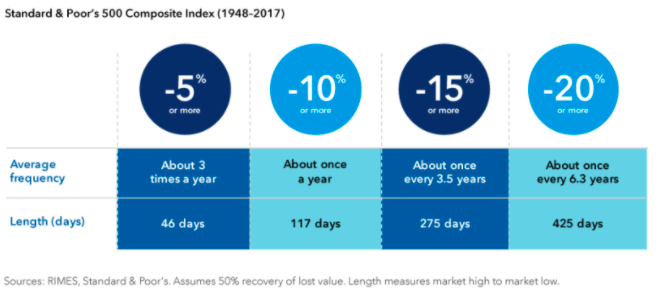Advisor Commentary
AFTER several months of positive growth global equity markets declined in September. This has historically been a volatile month and in addition to that several macro-economic factors continued to cause questions for investors. Markets have not experienced this level of volatility since the start of the global pandemic almost 20 months ago, so in this quarter’s commentary we will break down some of these economic factors and attempt to answer the question; “What’s causing so much uncertainty?”
BEFORE we answer this question though, it’s important to remember that market pullbacks are more common than some may think. Pullbacks have been uncharacteristically infrequent in recent years with the S&P index posting just seven corrections of 10% or more since the financial crisis in 2009. Even a 5% decline over a short period can feel unsettling, but can occur on average three times per year. As seen in the chart below, history shows that market corrections of 10% or more are surprisingly common and have happened on average once per year since 1948.

INFLATION – According to Statistics Canada, inflation topped 5% in Q3 in large part due to supply chain disruptions and employment shortages as the economy reopens. The economics team at IA Clarington recently noted that they believe we are near the peak at 5-6% and they expect to see inflation metrics going down likely through the end of the year. Currently, inflation is climbing faster than the average hourly wage for Canadian and U.S. employees which could decrease consumer’s purchasing power however, it was also noted that much of the inflation we are seeing is due to a shortage of supply, not demand.
SUPPLY CHAIN DISRUPTIONS – The good news is that consumer demand is still at a relative high as there is pent up demand for goods and services coming out of the Covid lockdowns. The challenge though for many sectors is meeting this demand. There is no one factor that’s causing these supply disruptions but some of the most notable include container and shipping costs, port productivity (currently at half its pre-covid levels) (source – Gene Seroka of the Port of Los Angeles), truck driver shortages worldwide and warehouse capacity being bottlenecked. It’s hard to identify exactly when all of these factors will be resolved but the majority of the experts we talk to believe these are temporary concerns which will eventually be resolved with time, perhaps into the second quarter of 2022.
TAPERING OF QUANTITATIVE EASING & RATE INCREASES – As a refresher, quantitative easing is a monetary policy in which central banks purchase predetermined amounts of government bonds or other financial assets in order to inject money into the economy and bring down the cost of borrowing (lower interest rates). Tapering is the process of slowing these purchases and is the first step toward eventually increasing interest rates to a more historically normal level. In the minutes from their September meeting, we learned that the U.S. Fed will likely start tapering in mid-November unless something significant occurs. A recent report from Bloomberg Research shows that there is currently a 100% certainty that the Bank of Canada will start hiking rates on or before their April 2022 meeting and U.S. Fed will likely do the same by the end of 2022.
U.S. DEBT CEILING & INFRASTRUCTURE SPENDING – Markets have responded positively in recent days knowing the U.S. will not default on its debts after the U.S. Senate’s decision to pass a bill raising the debt ceiling into early December. While this is only a temporary solution, it at least takes one near-term headwind off the table and should be a sigh of relief to investors. That said, President Biden still hasn’t gotten his major infrastructure legislation through the Congress. U.S. House Majority Leader Nancy Pelosi has set October 31st as the new deadline for the bill but as more time passes, the less clear it becomes what markets will think about the US$2-trillion plan. CEO & CIO at AGF Investments, Kevin McCreadie, said on a call earlier this month that on one hand, fiscal stimulus of this magnitude could give the U.S. economy a needed boost but on the other hand, it raises the possibility of higher taxes that many believe is a risk that outweighs the legislation’s potential benefit.
CLEARLY THERE ARE several factors that have impacted investor sentiment through the third quarter but what’s important to highlight is that most, if not all of these concerns, are more for short-term traders than long-term investors. Recent corporate earnings reports are showing that many sectors are exceeding market expectations which has real investors wondering how much of the September sell-off was, yet again, investors acting on headlines instead of focusing on the long-term expectations of the businesses they own. Our friends at EdgePoint Wealth Management put out a timely note last week explaining how increasingly shorter time horizons are detrimental to an investor’s returns and the important goal of reaching their end objective. We remain focused on partnering with portfolio managers who can block out the noise and build portfolios that will withstand the natural market cycle and ultimately compound wealth in the long-term.
Updates & Reminders
- AGF Session
We would like to invite you to an exclusive live session on November 18th at 2pm where we will be speaking with AGF Investment’s Chief U.S. Policy Strategist Greg Valliere. Greg has over four decades of experience following US politics in Washington DC and is frequently interviewed and quoted on BNN, Bloomberg, Fox, CNBC & CNN. We are very excited to have the opportunity to speak with Greg and hope you can join us. Please note that a recording of the session will be made available for anyone who is not able to join the call live. Click Here to learn more and register for the event.
- Insurance Review
We spend a great deal of time working with clients on planning for retirement and building sound investment strategies but one area of planning that can often be overlooked is in protecting their hard-earned capital from uncertainty outside the investment market. Some families spend decades building their net worth according to plan only to have things upended by the unexpected. Using insurance to protect against an unexpected injury, illness or death is an extremely important part of building a sound financial plan. If you already have these insurances in place personally, through an employer or not at all, it’s important to review your insurance needs on a regular basis to ensure you are sufficiently protected. Don’t let the unexpected get in the way of accomplishing you and your families’ long-term financial objectives. Please reach out to our team or mention it at your next review meeting to set up a complementary review of your insurance needs.
- End of the Year Prep
With the end of the year fast approaching, it’s not too early to start putting a plan together for next year. Whether it’s getting ahead of RRSP season, reviewing your income needs and plan contributions or planning for tax-season, our team remains ready to help you develop a sound plan that allows you to hit the ground running in the new year and make the most of 2022. CLICK HERE to set up an appointment.






